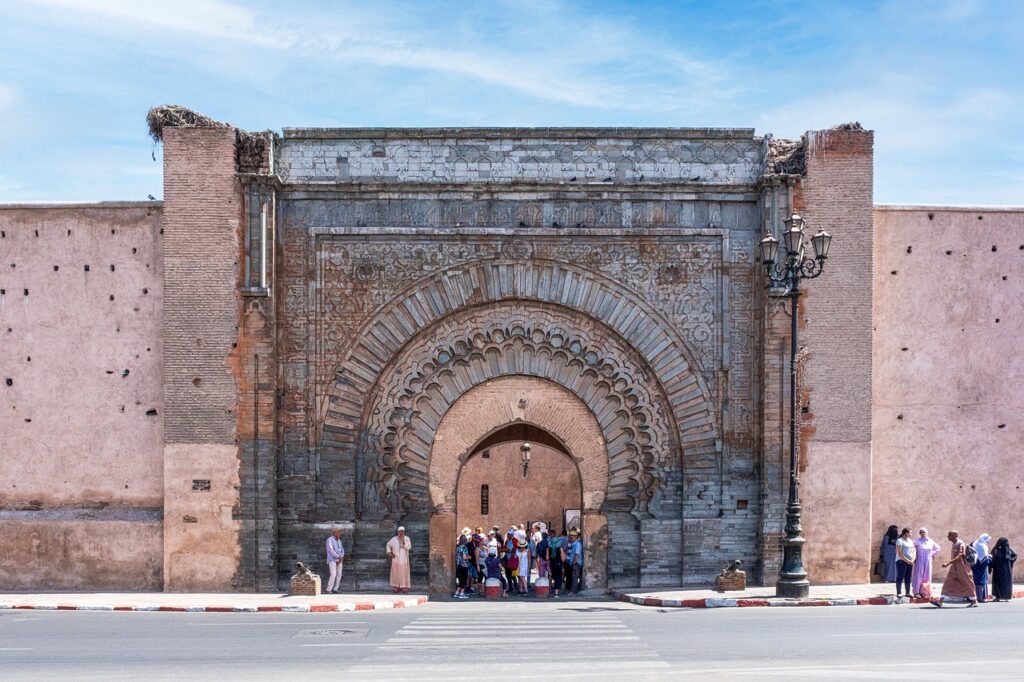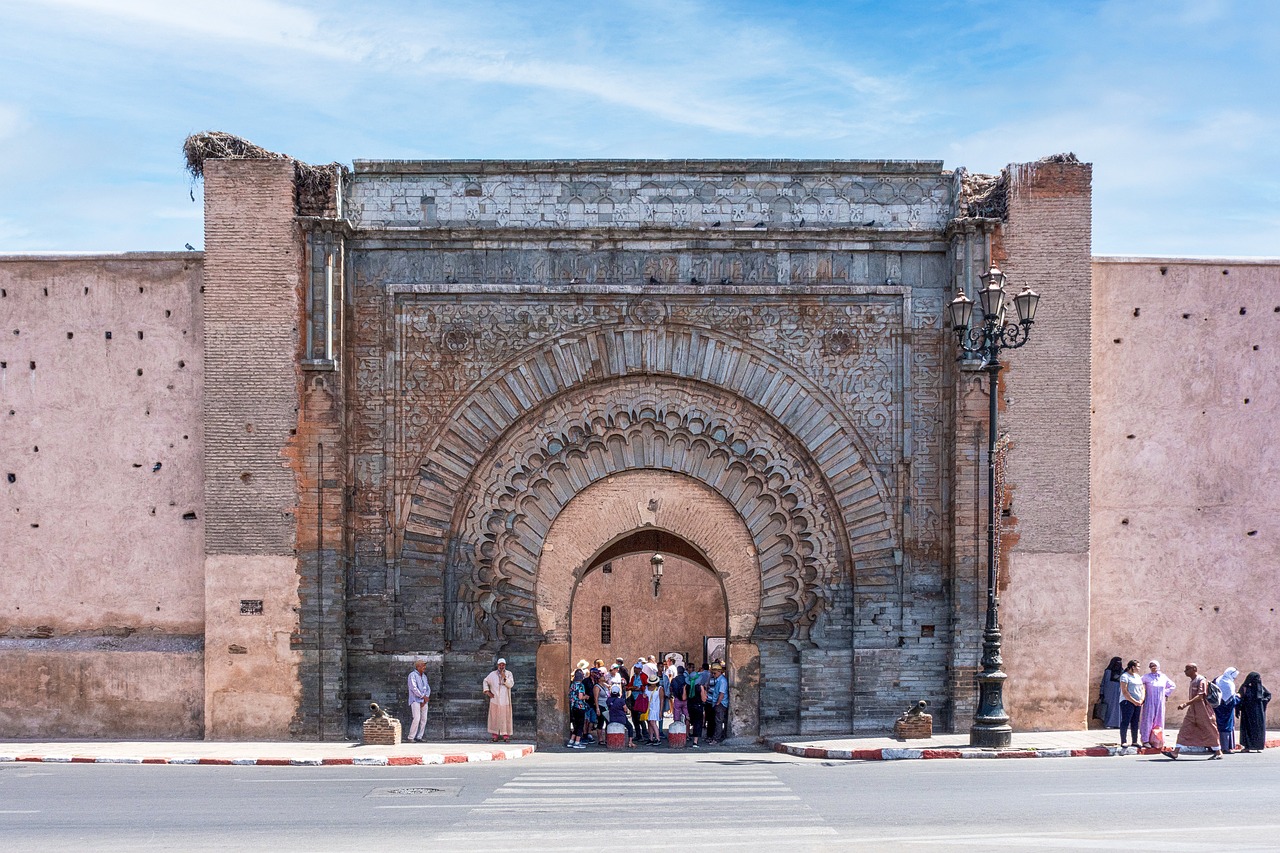List of Historical Monuments in Marrakech

Monuments in Marrakech, also known as the Red City, have earned its reputation as one of North Africa’s most renowned tourist destinations. Its prominence stems from a rich history that is vividly embodied in the city’s historical landmarks. Established in 1062 by Yusuf Ibn Tashfin, ruler of the Almoravid Empire, Marrakech, meaning the Land of God in the Amazigh language, stands as an imperial city adorned with grand and marvelous historical monuments. These structures not only showcase the city’s historical legacy but also serve as captivating examples of the Moroccan art of urbanism. To delve into the heart of Marrakech cultural narrative, explore six key historical monuments that exemplify the city’s artistic heritage and storied past.
- Check out our best tours from Marrakech
Jamaa El Fna Square
Jemaa El Fna, situated adjacent to the Koutoubia Mosque in Marrakech, is a vibrant hub that perennially captivates millions of visitors. This bustling square is renowned for hosting a diverse array of performances featuring snake charmers, monkey trainers, storytellers, musicians, and other revered artists. The eclectic mix of talents converges to create a lively and enchanting atmosphere that has become emblematic of the city’s cultural richness.
In recognition of its unique cultural significance, the cultural space of Jemaa el-Fna was rightfully acknowledged by UNESCO in 2001, earning the esteemed status of an intangible cultural heritage of humanity. Jemaa El Fna Square stands as more than just a bustling marketplace; it is a historical landmark that serves as a testament to Morocco enduring cultural heritage, inviting visitors to immerse themselves in the captivating tapestry of Marrakech traditions and artistic expressions.
Bahia Palace
Bahia Palace, founded in the 1860s by Si Musa, the vizier of Sultan Hasan I, stands as a historical gem situated in the North of the Al-Mallah district. Covering an expansive area of 8000 square meters, this monumental structure offers a glimpse into a bygone era. While visitors are restricted to a limited part of the palace, its rich history and architectural splendor are undeniably captivating.
Originally designed as a spacious courtyard mansion (a Riad) in the Andalusian style, Bahia Palace underwent continuous enhancements, transforming it into one of the most luxurious places of its time. Today, the palace exudes mesmerizing charm, featuring Andalusian-Moorish gardens, ornate fountains, room galleries, a mosque, a steam room, Islamic gardens, and patios.
A testament to momentous and intricate architecture, Bahia Palace stands as a beautiful representation of cherished cultural heritage for Moroccans and a must-visit destination for those seeking to immerse themselves in the historical grandeur of Marrakech.
Badi Palace
Not far from Bahia Palace, Badii Palace emerges as a lasting testament to the triumphant victory of Ahmad El-Mansur Addahabi, Sultan of the Saadian, in the Battle of The Three Kings. Often referred to as The Incomparable (or Inimitable) Palace, Badii Palace stands as a symbol of grandeur, constructed between 1578 and 1594 in the northeast corner of the Casbah.
While time has worn away its former splendor, the ruins that remain tell the story of its magnificence. Unfortunately, the decay was orchestrated by the Alaouite Sultan Moulay Ismail. Despite the remnants, this architectural complex is a gem of Islamic art, featuring a vast courtyard flanked by two identical pavilions, small gardens, and additional structures, including two open galleries.
Badii Palace, like its counterpart Bahia Palace, serves as more than a historical relic, both locations play host to cultural events, most notably the “Marrakech du Rire” festival. This further enriches the experience for visitors, offering a blend of historical appreciation and contemporary vibrancy in the heart of Marrakech.
Koutoubia Mosque
The Koutoubia Mosque, situated in the southwest of the medina near Jamaa Lafna square, stands as a towering testament to religious significance and architectural brilliance. Soaring to a height of 77 meters, it claims the title of the largest mosque in Marrakech, making it a prominent feature in the city’s skyline and a key landmark.
Originally founded during the Almoravid dynasty in 1120, the Koutoubia Mosque saw completion during the reign of the Berber Almohad Caliph Yaqub al-Mansour (1184-1199). Crafted with meticulous detail, the mosque incorporates a sturdy blend of bricks, sandstone, and ceramic tiles. Its structural components include a house of prayer featuring 17 halls supported by substantial pillars, a striking tribune, the central nave, a minaret adorned with an arrow and orbs, and an expansive square surrounded by gardens.
While entry into the mosque is exclusive to Muslims for prayer, the exterior offers a captivating spectacle, especially during the serene moments of sunset, sunrise, and illuminated nights. The Koutoubia Mosque, with its impressive stature and historical significance, stands as a captivating symbol of Marrakech’s cultural and architectural heritage.
Medersa Ben Youssef
The Medersa Ben Youssef stands as a historic Islamic college, a cultural jewel nestled in the heart of Marrakech, Morocco. Commissioned by the Saadian sultan Ahmad al-Mansour (1578-1603), its construction unfolded between 1584 and 1585, marking the inception of the university’s existence.
What sets this edifice apart is its exceptional carved cedar roof beams, meticulously arranged in a captivating grid pattern. Enclosed by an outer wall, the Medersa features a courtyard adorned with an entrance gate. Flanking the gate are two expansive halls, serving as prayer rooms during religious festivities. At the center of the courtyard, a small mosque with an ablutions fountain adds a touch of serenity.
Spanning three floors, the Medersa reveals a thoughtful design: a lower level, once home to students living and studying, a middle level housing classrooms; and an upper level boasting a prayer room that provides a panoramic view of the city. Beyond its architectural magnificence, the Medersa Ben Youssef encapsulates centuries of learning and spiritual reflection, making it a must-visit destination for those seeking to delve into Marrakech rich cultural tapestry.
Menara Gardens
Menara, a sprawling botanical haven, graces the Menara district, in close proximity to Jamaa Lafna Square. Rooted in history, this monumental garden traces its origins to the 12th century, a testament to the foresight of the Almohad dynasty and the directive of King Abdelmoumen Almohad. Originally designed as a training ground for soldiers, Menara Gardens have evolved into a serene expanse, inviting visitors into a lush realm.
Dominated by an extensive green space adorned with olive trees, Menara Gardens provide an idyllic setting for leisurely picnics and leisurely strolls. At its heart stands a pavilion, featuring a distinctive green pyramid-shaped dome, overlooking a basin filled with artfully arranged artificial water. This architectural juxtaposition adds to the charm, creating a picturesque scene that beckons both locals and tourists alike.
Menara Gardens, with its historical roots and natural beauty, stand as a major destination, inviting all to immerse themselves in the tranquility and allure of Marrakech’s botanical heritage.
Saadian Tombs
Constructed in the late 16th century during the reign of Ahmad El-Mansour, this historical marvel stands proudly in the Casbah district. The Saadian Tombs, an architectural testament to the Saadian Sultans and their family members, exudes a captivating blend of Moroccan-Andalusian artistry in its urban design.
Immersed in pottery motifs, dazzling Zellij, and intricate wood carvings, the Saadian Tombs emerge as a magnetic attraction for visitors. The monument unfolds on two sides, each revealing a tapestry of historical significance and artistic finesse. The first side comprises three distinct rooms: a mosque, the central Twelve Pillars Room, and the Wood Ceilings Room, adorned with inscriptions commemorating Sultan Abd El-Ghaleb and his father.
On the second side stands the Lalla Masouuda Dome, anchoring the center of this architectural complex. The Saadian Tombs, with their rich ornamentation and historical resonance, invite exploration and reflection, making them a must-visit destination for those seeking a deeper understanding of Marrakech’s cultural heritage.
Dar Si Said Museum
The Dar Si Said Museum, nestled in Marrakech, stands as a dedicated tribute to Moroccan wood craftsmanship, representing an awe-inspiring historical monument in Morocco. Originally constructed as a mansion in the late nineteenth century by Si Said, the brother of Ahmed Ba and Grand Vizier Moulay Abdelaziz, the museum took its present form in 1932.
Once a residence reflecting the opulence of its era, the Dar Si Said Museum now serves as a captivating repository of Morocco rich woodcraft heritage. Visitors are invited to explore the intricacies of Moroccan woodworking, housed within the walls of this historical gem. The museum, with its roots in the late nineteenth century, offers a fascinating journey through time, providing insight into the cultural and artistic legacy of Marrakech.
Bab Agnaou
Nestled in the southwestern medina of Marrakech, Morocco, Bab Agnaou stands as a historic monument built by the Almoravid dynasty (1056-1147). Its square shape, adorned with gates to the east and west, evokes a timeless architectural elegance. The name “Bab Agnaou” finds its origin in the Arabic term for garden gate.
This monumental structure serves as one of the principal gateways to Marrakech medina, acting as a tangible link to the city’s rich history. Positioned at the culmination of an avenue stretching from Bab Ait Ben Haddou to Place Jemaa el Fna, one of the city’s pivotal squares, Bab Agnaou holds a significant place in Marrakech urban landscape. As visitors pass through its gates, they go on a journey through centuries, immersed in the cultural tapestry of this vibrant Moroccan city.
What is the famous gate in Marrakech?
One of the famous gates in Marrakech is Bab Agnaou. Located in the southwestern medina, Bab Agnaou is a historic gate built by the Almoravid dynasty (1056-1147). It has a square shape and is renowned for its architectural elegance and historical significance. The name “Bab Agnaou” is derived from the Arabic term for garden gate. This monumental structure serves as one of the main entrances to Marrakech medina, connecting the city’s past with its present.
What is special in Marrakech?
Marrakech, a city known for its vibrant atmosphere and cultural richness, boasts a UNESCO-listed medina filled with historic sites and bustling souks. Jemaa El Fna Square takes center stage, offering a dynamic blend of street performers, musicians, and food stalls, transforming into a lively night market as the sun sets. The city’s historical monuments, including the Koutoubia Mosque, Saadian Tombs, and Bahia Palace, showcase Marrakech architectural and cultural heritage.
Beyond its historical charm, Marrakech delights visitors with beautiful gardens like the Majorelle Garden and Menara Gardens, providing peaceful retreats amidst the urban hustle. The city’s cuisine, highlighted by traditional Moroccan dishes and diverse dining options, adds a flavorful dimension to the experience. Marrakech cultural festivals, from the International Film Festival to artistic gatherings, underscore its dynamic and creative spirit, making it a special and captivating destination for travelers.
What to avoid in Marrakech?
In Marrakech, it’s advisable to be cautious of overly aggressive street vendors and unofficial guides in the bustling medina. Politely decline unwanted offers and opt for licensed guides to ensure a trustworthy experience. Additionally, be vigilant against petty theft, especially in crowded areas, and safeguard your belongings.
When exploring Marrakech, use official taxis with meters to avoid misunderstandings about fares and steer clear of unmarked vehicles. Stick to bottled water, as tap water may cause stomach issues, and be mindful of public displays of affection, particularly in more conservative areas. By staying informed and exercising common-sense precautions, visitors can make the most of their Marrakech experience while ensuring a safe and enjoyable stay.
Why is Marrakech all red?
Marrakech is often referred to as the Red City due to the predominant use of a distinctive reddish-brown shade in its traditional buildings and structures. The city’s unique reddish hue is attributed to the use of locally sourced red sandstone and clay in construction. The natural materials, abundant in the surrounding region, give Marrakech its characteristic color, creating a warm and earthy ambiance.
The use of red sandstone not only reflects the availability of local building materials but also serves practical purposes. The reddish color helps regulate temperatures in the city, providing insulation against the heat. This architectural choice, coupled with the aesthetic appeal of the reddish tones, contributes to Marrakech identity as the Red City, making it one of the distinctive features that add to the city’s charm and allure.
What is the main food in Marrakech?
Marrakech culinary scene is characterized by flavorful dishes such as tagine, slow-cooked stews with meat and vegetables, and couscous served with aromatic spices. The city is renowned for its delectable pastries, including almond-filled briouats and honey soaked pastilla. Meat enthusiasts can savor mechoui, a dish featuring slow-roasted lamb. Harira, a traditional soup, is often enjoyed during Ramadan. Moroccan mint tea, a cultural staple, is served sweet and refreshing. Marrakech’s street food offerings, from grilled meats to snacks like chebakia, add vibrancy to the city’s diverse and delightful gastronomic landscape.
Why is Marrakech worth visiting?
Marrakech is worth visiting for its captivating blend of history, culture, and vibrant atmosphere. The city’s UNESCO-listed medina boasts ancient streets, bustling souks, and architectural marvels like the Koutoubia Mosque. The rich tapestry of historical monuments, such as the Saadian Tombs and Bahia Palace, provides a glimpse into Morocco past. Marrakech distinctive red architecture and the lively Jemaa El Fna Square create a unique ambiance. The city’s diverse cuisine, from aromatic tagines to sweet pastries, is a culinary delight. Marrakech gardens, like Majorelle Garden, offer tranquil escapes. The warmth of Moroccan hospitality and the allure of its traditional riads make Marrakech a destination that immerses visitors in a rich cultural experience

